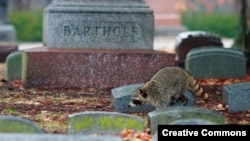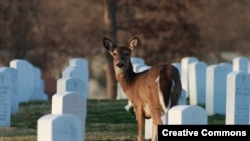Cemeteries are typically associated with death, but life abounds among the gravestones. As the growth of cities and farms across the United States has encroached on fields and woodlands, graveyards have become a refuge for some of the animals pushed out of those wild spaces.
Seth Magle, who directs the Urban Wildlife Institute in Chicago, suspects that most of the species that are found in cities are probably also using cemeteries. “Red foxes, skunks, woodchucks, opossums, white-tailed deer, beaver,” along with more common city residents, like birds and squirrels.
It’s easy to see why animals would be drawn to cemeteries. They’re quiet, for the most part. The largest ones may cover hundreds of hectares, with trees, rows of hedges, and many secluded spots for nesting, or hiding. But Magle says some animals can forage even in a place that’s just gravestones and grass.
“Species like coyotes are not terribly selective about that kind of stuff," he explained. "Seems like mostly what they’re looking for in these urban areas are rabbits, and rabbits like grass. So the rabbits will come in for the grass, and then the coyotes may come in for the rabbits.”
A cemetery census
The 120 hectares and thousands of mature trees of Bellefontaine Cemetery, in St. Louis, Missouri, make it an especially attractive refuge. And the managers of this 19th century cemetery want to do even more to attract wildlife. So they invited scientists and students from the University of Missouri-St. Louis to spend a night among the gravestones to survey some of the animals that currently call the cemetery home.
Wildlife biology student Vona Kuczynska focused on bats. She and some of her helpers set up fine mesh nets before sunset to trap the flying mammals so they could be identified and counted. Some species of bats are really gentle, she says, and don’t seem to mind being handled. “Whereas other bats — usually the bigger bats — are way more aggressive, and they’ll try to bite you and escape and do all these things.”
While Kuczynska counted the bats of Bellefontaine, other researchers looked at the night-flying moths.
Urban islands of biodiversity
The idea of cemeteries as wildlife habitat may seem kind of strange here in America, where most cemeteries are maintained and manicured in perpetuity. But in England, where — as in the U.S. — urban development and industrial agriculture have reduced wildlife habitat, it’s common practice to let at least the older parts of cemeteries go back to a more natural state.
According to Mandy Elford, who works as an ecologist for the city of Manchester, “Nobody wants to go to an overgrown grave for a loved-one. But we can have little messy places here and there.”
She says Manchester is actively trying to make its cemeteries more wildlife-friendly. "In the older parts of the cemetery, where perhaps people aren’t actually visiting anymore, they do mow paths through, but they tend to leave it a little bit more wild, so that the flora can come through and attract more insects, etc. So it means that the whole food chain’s there, right from the invertebrates up to the higher mammals, even close to the city center.”
That doesn't surprise Magle, who says that urban areas are ecosystems, and their green spaces — whether they are parks, golf courses, or cemeteries — are islands of biodiversity.
"All of the same dynamics as far as animals trying to find habitat, trying to find mates, trying to find shelter, all the same things that happen in the rainforest are happening all around us all the time," he said. "We just need to be aware of it."
And aware that even in cemeteries, there is life.







